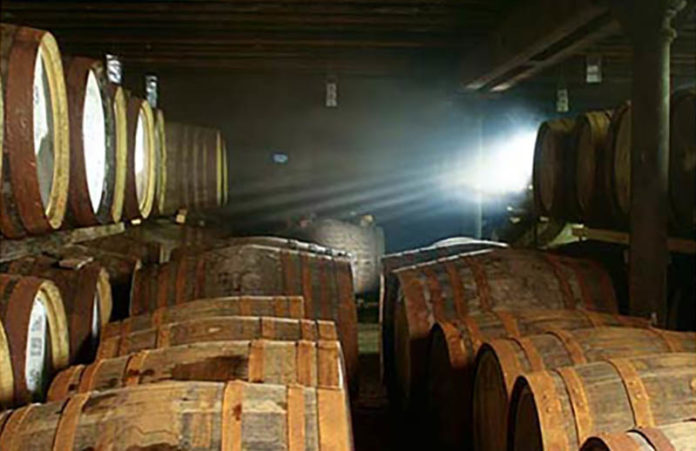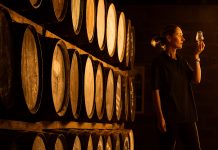Do you like a peaty Islay single malt or a lighter Lowland taste? Scotland’s national drink is now a worldwide favourite and England and Wales are getting in on the game. Join us in raising a glass and wishing ‘good health’ to whisky as we take a tour of some of the finest distilleries around Britain
A Scottish teacher working in Hungary once asked her pupils what they knew about Scotland. The three most popular answers were Rangers/Celtic, Nessie and whisky. Football is indeed a worldwide obsession and the Loch Ness Monster has even starred in a Hollywood film. But whisky is our national drink, our best-known product and our most lucrative export. And it’s a lot more even than that.
Whisky is first recorded in 1494; James IV, in residence at Falkland Palace, commissioned the monks of Lindores Abbey to produce some aqua vitae or ‘water of life’. The Gaelic for ‘water of life’ is uisge beatha which, if you pronounce it correctly, sounds a bit like ‘whisky’ and so is the probable source of the name.
Of course, the monks of Lindores and many others had probably been producing the spirit long before James’ order was committed to paper and the spirit continued to be popular. The Scottish Parliament imposed its first duty on whisky in 1644; some would say it’s been downhill ever since in that department. The tide of taxation increased after the Union of 1707 and Robert Burns, the great celebrant of whisky ‘Whisky and freedom gang thegither’! worked as an exciseman for a while – a classic case of poacher turned gamekeeper.
The Highlands had a tradition of illicit stills, with artfully-hidden machinery bubbling away in hidden corners of quiet glens. Over the years, taxation and more effective policing gradually squeezed out home-produced firewater and the industry became commercialised, with many of the distilleries and brands we know today emerging during the 19th century. Fine gentlemen in the new Scottish sporting estates took to the native spirit with relish. Scots migrating abroad often took their whisky-distilling skills with them but also helped to form an overseas market for the product. As the British Empire expanded, uisge beatha became a popular ex-pats’ tipple in the pink-coloured bits of the map. Whisky was beginning to conquer the world.
In the early years of the Second World War, arms and equipment flowed into the United Kingdom from the United States. Payment was made where possible, though sometimes in kind rather than cash. Whisky was an understandably popular medium of exchange that Uncle Sam welcomed heartily. Not all of this payment-in-spirit arrived, though; in 1941, the SS Politician, carrying thousands of bottles of whisky for export to the USA, foundered off Eriskay. Much of the cargo was spirited away by locals, and the incident inspired Compton Mackenzie’s 1947 novel Whisky Galore and the 1949 Ealing film.
A dram is any individual serving of any whisky. The most celebrated whisky products are the single malts: spirit produced from malted barley, casked, matured and bottled on a single site with no additions from elsewhere. Scotch whisky blends are combinations of spirits from different locations, some made from malted barley and some from other grains. Many popular brands – Johnny Walker, The Famous Grouse, White Horse – are blends. Note that native uisge beatha is, correctly, ‘whisky’; American and Irish product is ‘whiskey’, with the distinguishing ‘e’; bourbon, incidentally, is produced mainly from corn. Canadian whisky also omits the ‘e’ as do some more surprising producers.
In Scotland, though, whisky isn’t just a product; it’s a magical, mysterious process. Fresh hill water and malted barley are combined and transformed, mystically, into the golden liquid and matured in vintage barrels with a patience that seems quite at odds with the frenetic pace of modern life. This process often takes place in locations of dramatic natural beauty, and many such distilleries can be visited for tours and tastings. Several distilleries are located along the western seaboard and its islands and tourists can follow a trail named the Whisky Coast. There’s a particular concentration of distilleries on Islay, producing the famous single malts with evocative names like Laphroiag, Bruichladdich and Lagavulin.
Much farther east, there’s another whisky trail in the country where the Spey emerges from the couchant lion forms of the Cairngorms. Among the famous names in this part of the country are Glenfiddich, Tamdhu and Macallan.
If the western Highlands and Islands and Speyside are the heartlands of modern whisky production, it’s still a Scotland-wide industry, with distilleries in the North Highlands (including Glenmorangie near Tain), Orkney, Highland Perthshire, Glasgow, Edinburgh and as far south as Bladnoch near Wigtown. Dallas Dhu, near Forres, is a preserved distillery open to the public and run by Historic Scotland and Glenturret Distillery, in Perthshire, now offers The Famous Grouse Experience. May was designated Whisky Month in Scotland’s Homecoming 2009 celebrations, with whisky-themed events at Inveraray Castle (Spirit of the West) and throughout Speyside (Spirit of Speyside, held annually).
Now, however, there’s whisky being produced much farther south than Scotland. The 21st century has seen a discreet return to production in both Wales and England. In the Brecon Beacons National Park, Penderyn Distillery began producing Wales’ only single malt in 2000 and opened a visitor facility in 2008. The English Whisky Company operates from St George’s Distillery (of course) at Roudham in Norfolk. They have been in business since 2006 and run daily tours of the facility. You’ll notice that both Wales and England adhere to the e-free spelling of ‘whisky’.
And whether you go for a taste at a distillery or sample your spirit at home, and whether you go for Scotch, English or Welsh whisky, never forget to toast with the words “slainte mhath!” (good health!) and receive the response “slainte mhor!” (great health!).






 © 2024
© 2024